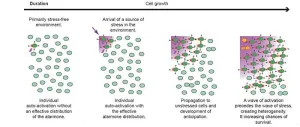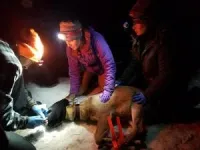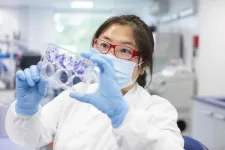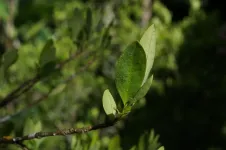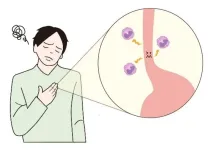Discovery of a new defense mechanism in bacteria
2024-07-10
(Press-News.org)
When confronted with an antibiotic, toxic substance, or other source of considerable stress, bacteria are able to activate a defence mechanism using cell-to-cell communication to ‘warn’ unaffected bacteria, which can then anticipate, shield themselves and spread the warning signal. This mechanism1 has just been described for the first time by a team of scientists2 from CNRS and Université de Toulouse III – Paul Sabatier. It paves the way for the development of new, more effective antibiotic treatments that can target this bacterial communication system.
When they perceive a source of stress, bacteria spring into action, inducing changes in the expression of certain genes and their physiological properties to make them less vulnerable to the detected lethal substance. They also produce small ‘alarmone’ proteins3 on their surface in order to contact and activate random neighbouring bacteria. Unstressed bacteria can only change state in the presence of a sufficient amount of alarmones. Thus, only a source of stress perceived by sufficient bacteria can trigger propagation of this activation4.
The mechanism offers several advantages: it limits the unnecessary use of energy and enables a rapid and coordinated response in the population. Because activation is gradual, it creates diversity in the population over time, thus increasing the bacteria’s chances of survival.
These findings, published on 10 July in Nature Communications, were established using a dozen different families of antibiotics on populations of Streptococcus pneumoniae, the bacteria that causes pneumococcal infections.
Notes
1 – Known as Self Induction and Propagation (SI&P)
2 – Working at the Laboratoire de microbiologie et de génétique moléculaires (CNRS/ Université Toulouse III-Paul Sabatier)
3 – Also known as Competence Stimulating Peptide (CSP)
4 – This prevents the mechanism from being triggered when the source of stress only affects a single bacterial cell. Activation due to an internal source of stress that is unique to a cell, for example, does not trigger the mechanism.
END
ELSE PRESS RELEASES FROM THIS DATE:
2024-07-10
The capacity of Mozambican woodlands to capture and store carbon is underestimated and potentially undervalued for their protection and restoration, finds new research from an international team of scientists including UCL researchers and led by carbon data provider Sylvera.
The research, published in Nature Communications Earth & Environment, found that miombo woodlands, which span large areas of Sub-Saharan Africa, store 1.5 to 2.2 times more carbon than had previously been estimated by standard methods.
Named for the miombo trees found in the region, these biomes (geographical areas defined by their local species and ...
2024-07-10
Cutting farm nitrous oxide emissions helps climate and ozone layer
Adding crushed basalt rocks and special fertilisers can reduce potent nitrous oxide (N2O) greenhouse gas emissions and safeguard the stratospheric ozone layer, which protects us from harmful UV light and reduces nitrate leaching into water bodies protecting ecosystems and human health
The new study, led by researchers at the University of Sheffield, highlights methods for reducing N2O emissions, such as enhanced weathering of agricultural soils with ...
2024-07-10
Drugs developed to fight blood and other cancers could also help improve the efficiency of radiotherapy in the most commonly diagnosed low-grade brain tumour in adults, a new study has found.
Meningioma account for approximately 36% of all primary brain tumours. The majority are successfully treated by surgery, but some which can’t easily be accessed need to be treated with radiotherapy. That can cause significant side effects and radiation damage to the brain, while resistance to radiotherapy can also result in tumour growth.
A new study by researchers at the Brain Tumour Research ...
2024-07-10
New research published in Arthritis & Rheumatology indicates that chronic exposure to air pollutants may increase the risk of developing lupus, an autoimmune disease that affects multiple organs.
For the study, investigators analyzed data on 459,815 participants from the UK Biobank. A total of 399 lupus cases were identified during a median follow-up of 11.77 years. Air pollutant exposure was linked with a greater likelihood of developing lupus. Individuals with a high genetic risk and high air pollution exposure had the highest risk of developing ...
2024-07-10
Anthracnose, a severe disease caused by the Colletotrichum spinaciae plant pathogen, often occurs in common vetch, a widely grown legume. Chemicals are not recommended for disease management because the plants are used as livestock feed. A new study published in Grassland Research reveals that treating common vetch with certain bacteria or fungi that promote plant growth may be effective for combating anthracnose.
Treating common vetch with these bacteria or fungi increased the activity of plant defense enzymes and promoted the presence of healthy bacteria that could keep Colletotrichum spinaciae at bay.
“The combined use of plant growth‐promoting rhizobacteria such as Bacillus ...
2024-07-10
In a study in the Journal of Cosmetic Dermatology that included 60 individuals with mild to moderate acne, following the Mediterranean diet and taking omega-3 fatty acid supplements led to significant reductions in inflammatory and non-inflammatory skin lesions, as well as improved quality of life.
Notably, 98.3% of participants had omega-3 fatty acid deficits at the start of the study. Acne severity lessened significantly in those who reached target omega-3 fatty acid levels during the study.
“Lifestyle interventions, including dietary recommendations, should ...
2024-07-10
Unaccompanied children entering the United States without adult legal guardians and legal status account for a growing share of U.S. Border Patrol encounters along the southern border, with most fleeing extreme violence, poverty, and food insecurity. In response, emergency intake sites and influx care facilities (surge facilities) were used to promptly house unaccompanied children. A new analysis published in Economic Inquiry finds that the emergency shelters expedited the reunification of children with their families.
By analyzing data on unaccompanied minors encountered ...
2024-07-10
In people with a rare condition called light chain amyloidosis, light chain proteins—which are a component of antibodies—mutate and build up in different organs. In new research published in The FEBS Journal, investigators have identified and characterized an antibody fragment that can bind to abnormal light chains to stabilize them and prevent their aggregation.
The findings could have an important clinical impact because the current prognosis for individuals with light chain amyloidosis is extremely poor, and current treatments, ...
2024-07-10
A new paper in Molecular Biology and Evolution, published by Oxford University Press, indicates that while the United Nations Office on Drugs and Crime has collected annual data on areas of coca cultivation in South America for decades – to monitor the establishment of illegal plantations and associated deforestation – scientists can’t reliably distinguish between different types of coca plants. While identification often relies on leaf shape and size, this does not reflect differences between coca varieties grown for extracting the alkaloid cocaine (the active ingredient in the recreational drug), coca cultivated for traditional purposes, ...
2024-07-10
Osaka, Japan — In one of the first studies of its kind in Japan, Osaka Metropolitan University-led researchers uncovered the incidence and prevalence of the chronic allergic disorder eosinophilic esophagitis, or EoE.
EoE can cause difficulty in swallowing with tissue inflammation and fibrosis as eosinophils, a type of white blood cell, build up in the esophagus. EoE cases have been increasing in North America and Western Europe since the 1990s, but little has been known about the situation in Asia including Japan.
Dr. Akinari Sawada, Associate Professor Fumio Tanaka, and Professor Yasuhiro Fujiwara of OMU’s Graduate School of Medicine and colleagues analyzed a ...
LAST 30 PRESS RELEASES:
[Press-News.org] Discovery of a new defense mechanism in bacteria
